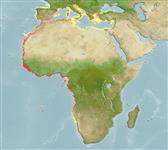>
Clupeiformes (Herrings) >
Dorosomatidae (Gizzard shads and sardinellas)
Etymology: Sardinella: Latin and Greek, sarda = sardine; name related to the island of Sardinia; diminutive (Ref. 45335).
More on author: Lowe.
Environment: milieu / climate zone / depth range / distribution range
Écologie
marin; saumâtre pélagique; océanodrome (Ref. 51243); profondeur 0 - 80 m (Ref. 27000). Subtropical; 24°C - ? (Ref. 54872); 46°N - 23°S, 17°W - 36°E (Ref. 54872)
Atlantic Ocean: southern and eastern parts of Mediterranean Sea, also penetrating the Suez Canal (Ref. 188, 50345), and eastern Atlantic Ocean, from Gibraltar southward to Angola and a single recorded specimen from Walvis Bay in Namibia (Ref. 188, 5286, 81269, 81631, 86940).
Length at first maturity / Taille / Poids / Âge
Maturity: Lm 13.4, range 11 - 19.5 cm
Max length : 30.0 cm SL mâle / non sexé; (Ref. 188); common length : 25.0 cm SL mâle / non sexé; (Ref. 188); poids max. publié: 927.00 g (Ref. 3808)
Épines dorsales (Total): 0; Rayons mous dorsaux (Total): 18-23; Épines anales 0; Rayons mous anaux: 17 - 23; Vertèbres: 44 - 48. Diagnosis: Body elongate, but variable in depth, belly fairly sharply keeled; with 14-20 pre-pelvic and 12-15 post-pelvic scutes, total scutes 31-34; lower gillrakers 70-166, increasing with growth; upper pectoral finrays white on outer side, the membrane between black (Ref. 188, 3259, 81269, 81631). It resembles Sardinella aurita, but pelvic fin with 1 unbranched and 7 branched rays vs. 1 unbranched and 8 branched rays in S. aurita and no black spot on hind part of gill cover, but faint gold or black area just behind gill opening (Ref. 187, 188). It is distinguished from S. rouxi by having more lower gillrakers, which is only 30-40 in S. rouxi, and the caudal fin grey, its tips almost black vs. pale yellow with distal margin dusky in S. rouxi (Ref. 187, 188, 81269).
A coastal, pelagic species, but tolerant of low salinities (Ref. 188, 5286, 27000, 86940); sometimes in estuaries and lagoons (Ref. 188, 2683). It forms schools, preferring waters of 24°C, at surface or at bottom down to 50m, strongly migratory (Ref. 188, 5286). It feeds on a variety of small planktonic invertebrates, also fish larvae and phytoplankton (Ref. 188, 27165). It breeds only once in the year, during the warm season between July and September, in coastal waters; juveniles and adults show clear north-south migrations in the Gabon-Congo-Angola sector and the Sierra Leone-Mauritania sector of the Atlantic Ocean, each area having nurseries; these movements are correlated with the seasonal upwelling (Ref. 188). It is of considerable importance off West African coasts, but combined with Sardinella aurita in most statistics, partly because both species are often caught together (Ref. 188).
Life cycle and mating behavior
Maturité | Reproduction | Frai | Œufs | Fécondité | Larves
Whitehead, P.J.P., 1985. FAO Species Catalogue. Vol. 7. Clupeoid fishes of the world (suborder Clupeoidei). An annotated and illustrated catalogue of the herrings, sardines, pilchards, sprats, shads, anchovies and wolf-herrings. FAO Fish. Synop. 125(7/1):1-303. Rome: FAO. (Ref. 188)
Statut dans la liste rouge de l'IUCN (Ref. 130435)
Menace pour l'homme
Harmless
Utilisations par l'homme
Pêcheries: hautement commercial; appât: usually
Plus d'informations
CollaborateursImagesStamps, Coins Misc.SonsCiguateraVitesseType de nageSurface branchialeOtolithesCerveauxVision
Outils
Articles particuliers
Télécharger en XML
Sources Internet
Estimates based on models
Preferred temperature (Ref.
123201): 18 - 27.9, mean 21 °C (based on 208 cells).
Phylogenetic diversity index (Ref.
82804): PD
50 = 0.5000 [Uniqueness, from 0.5 = low to 2.0 = high].
Bayesian length-weight: a=0.00813 (0.00660 - 0.01002), b=3.03 (2.99 - 3.07), in cm total length, based on LWR estimates for this species (Ref.
93245).
Niveau trophique (Ref.
69278): 3.2 ±0.38 se; based on food items.
Generation time: 3.2 (1.8 - 3.7) years. Estimated as median ln(3)/K based on 13
growth studies.
Résilience (Ref.
120179): Milieu, temps minimum de doublement de population : 1,4 à 4,4 années (K=0.34; tm=3; tmax=6).
Prior r = 0.57, 95% CL = 0.38 - 0.86, Based on 6 stock assessments.
Fishing Vulnerability (Ref.
59153): Moderate vulnerability (35 of 100).
Climate Vulnerability (Ref.
125649): Low to moderate vulnerability (32 of 100).
Nutrients (Ref.
124155): Calcium = 112 [59, 177] mg/100g; Iron = 1.65 [0.98, 2.68] mg/100g; Protein = 21.3 [20.4, 22.1] %; Omega3 = 0.457 [0.231, 0.866] g/100g; Selenium = 39.4 [20.0, 76.9] μg/100g; VitaminA = 30.2 [9.4, 98.4] μg/100g; Zinc = 0.755 [0.542, 1.131] mg/100g (wet weight); based on
nutrient studies.
